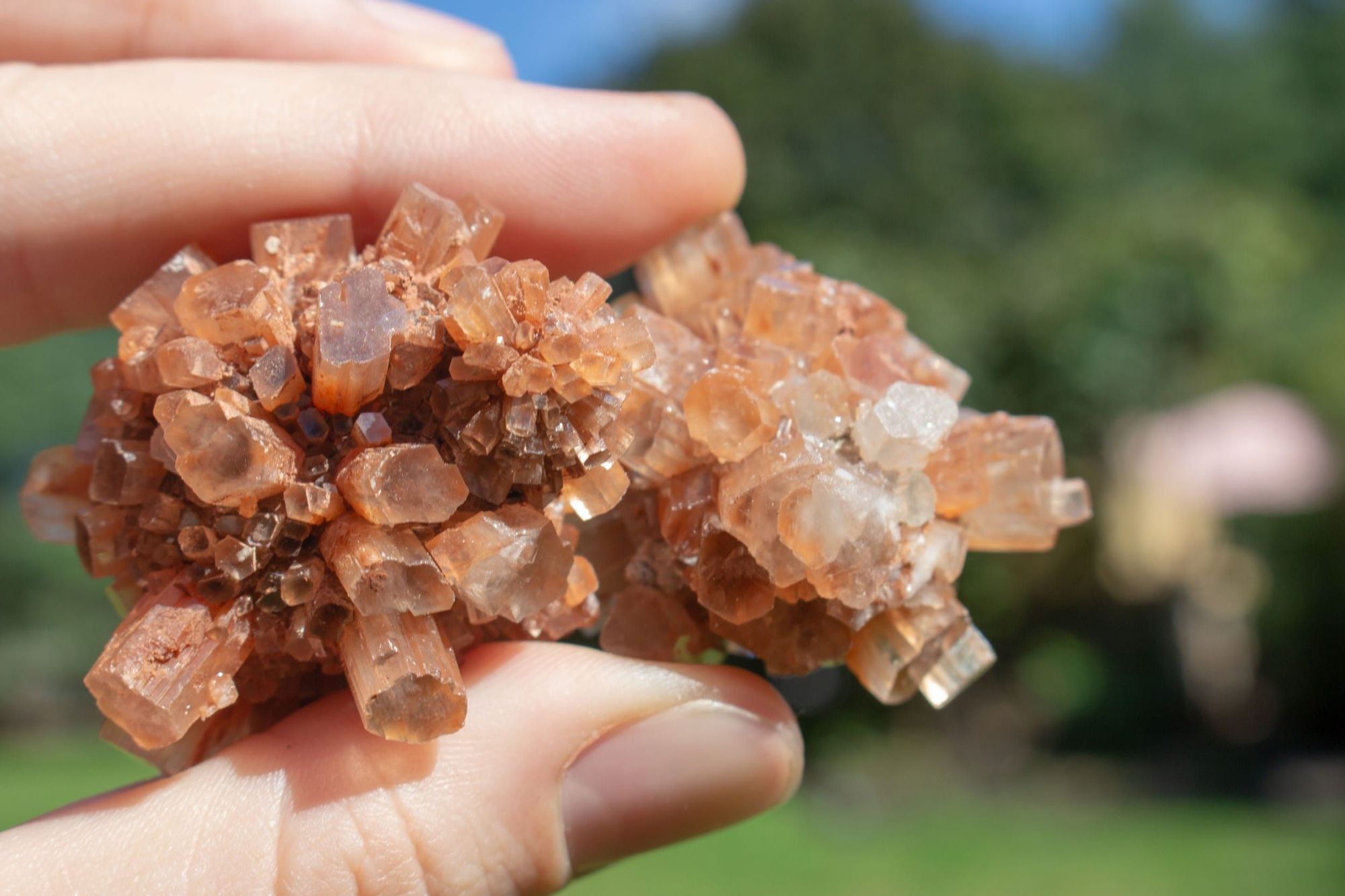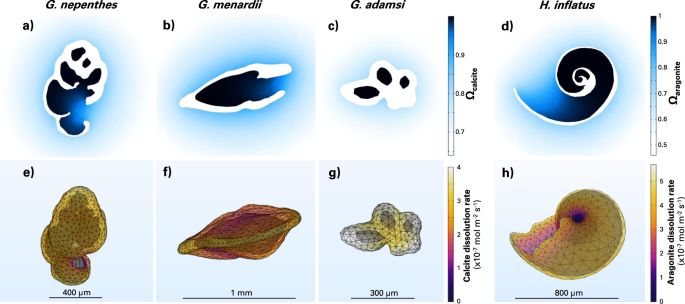Everything you need to know about Aragonite Crystal

Today we're going to be talking about Aragonite, many people are aware of this crystal's benefits but not of its origin and properties.
Aragonite is a powerful and versatile crystal that has been used for centuries in many cultures to promote healing, grounding, and well-being. Its unique properties as an orange crystal make it an ideal tool for those looking to improve their physical and emotional health.
Its stabilizing energy can help to promote feelings of calm and clarity, making it a valuable tool for anyone experiencing stress or anxiety. And its ability to buffer the deep ocean and promote preservation of other calcium-based materials, make it an important mineral for researchers and ocean enthusiasts.
In this blog post we will, explore the many benefits of aragonite, and discover how to use it to promote physical and emotional wellness, as well as its role in preserving marine life and the ocean's ecosystem.
What is Aragonite?
Aragonite is a mineral that is made up of calcium carbonate, which is often found in the form of orange or yellow hues, making it a unique and beautiful orange crystal. It is known to have many benefits when it comes to physical and emotional well-being.
Physical uses of Aragonite
From a physical perspective, Aragonite is used in aquariums to create conditions similar to those found in reefs. It provides important materials for marine life and helps maintain the pH level of the water to be similar to the natural level, this in turn helps preserve other calcium-based materials like shells and coral.
In addition, Aragonite has been successfully tested for the removal of pollutants like zinc, cobalt and lead from contaminated wastewaters.

Emotional uses of Aragonite for well-being
From an emotional perspective, Aragonite is said to have a grounding energy that can help to calm the mind and promote feelings of stability and security. It's believed to help us connect with the earth and our physical body, which can be beneficial for those who may be experiencing feelings of anxiety or stress.
As the use of social media has become increasingly prevalent, many people find themselves constantly distracted by notifications, news feeds, and other content. For students, this can be particularly challenging, as it can be difficult to focus on studies and maintain productivity. In this context, aragonite can be a useful tool for anyone looking to improve focus and concentration.
Placing a piece of aragonite on a study table can help to create a peaceful and focused environment that's more conducive to studying. By having a piece of aragonite nearby while studying can help to reduce distractions and improve productivity.
How to use Aragonite

Place it in your pocket/bag : Some practitioners recommend holding a piece of aragonite or placing it in the pocket to help soothe feelings of nervousness or agitation. Aragonite is said to help us connect with the earth and our physical body, which can be beneficial for those who may be experiencing feelings of anxiety or stress.
Hold it whilst meditating: Aragonite's energy is believed to be particularly effective in calming the mind, making it a valuable crystal for meditation and spiritual practice. It's said to help focus the mind and improve concentration, which can be beneficial for people who are looking to explore their spirituality or deepen their meditation practice.
Use it in a crystal grid : Crystal grids are arrangements of crystals placed in a specific pattern, with the intention of creating a particular outcome, often related to healing, manifestation, protection or balancing. Arranging aragonite crystals in a grid formation around your body can help to promote the release of toxins and increase energy flow.
Use it to decorate your space: Aragonite can be used as a decorative piece, they can be placed around the house, such as on shelves, windowsills, or tables. They can also be used in feng shui to create a positive energy flow in a space.
Aragonite is also used in water filtration for households
Aragonite is a form of calcium carbonate, and it can be used as a component in water filtration systems.
In the case of an under-sink drinking water filtration system that contains a cartridge of Aragonite material, it is said to function by reducing the hardness of the water, which is caused by the presence of calcium and magnesium ions, and converting it into aragonite form which is believed to be better for the human body.
Frequently asked questions about Aragonite
www.nochicares.com
Does Aragonite glow in the dark?
Aragonite does not glow in the dark on its own. It is not a phosphorescent mineral, which means it does not emit light in the dark after being exposed to light. Some other minerals such as Calcite, Fluorite and certain types of quartz may emit light after being exposed to light and they are called fluorescent minerals.
There are some aragonite specimens that are coated with a phosphorescent material that give them a glowing effect when they are exposed to UV light, but this is not due to the properties of the aragonite itself, but rather due to the coating on the specimen.
It's worth noting that some specimens can be treated to enhance their color or to improve their appearance. It's always important to check and ask if this is the case before buying any specimen and be aware that treated specimen have a lower value than the natural one.

Is Aragonite harmful to humans?
Aragonite is generally considered to be safe for humans to handle and use. It is a natural mineral that is not toxic and does not release any harmful chemicals. However, as with any mineral, it's always best to handle it with care and to use it appropriately. As aragonite can be brittle, it is important to avoid using excessive force or pressure when handling it.
Also, like with other types of minerals, there is some dust or dust created when cutting or grinding aragonite, so it is best to take precautions when handling it, such as wearing a dust mask or working in a well-ventilated area. Especially if you're prone to respiratory issues such as Asthma.
Is Aragonite rare?
Aragonite is not considered a rare mineral, it is commonly found in certain types of limestone, marine environments, and in certain types of organic-rich sedimentary rocks. It's also a component of some hydrothermal mineral deposit and can also be found as a secondary mineral in some caverns and caves.
Some varieties of aragonite can be rare, such as some specific formations, such as the spherical formations found in Las Choyas, Mexico, which are made from aragonite and are called "cave pearls" and are considered rare and valuable. Also, the blue aragonite, that can be found in some localities, is also considered a rare variety.
Is Aragonite the same as calcite?
Aragonite and calcite are two different mineral species, both are made up of calcium carbonate, but they have distinct crystal structures and properties.
Aragonite and calcite have similar chemical formulas, but they differ in their crystal structure. Aragonite has a orthorhombic crystal structure while calcite has a trigonal crystal structure.
Here are a few differences between aragonite and calcite:
- Solubility: Aragonite is more soluble than calcite in water, meaning that it dissolves more easily in water.
- Hardness: Calcite has a higher Mohs hardness than aragonite, it has a score of about 3.5, while calcite is 3. This means it's a lot harder than Aragonite.
- Environment: Calcite is more likely to be found in cool, deep-water environments and in rocks such as limestone and marble, while Aragonite is preferentially deposited in warm, shallow marine environments and in mollusk shells or coral skeletons.
- Color: calcite can be found in a variety of colors, from clear, white, grey, yellow, red and brown, while aragonite can be orange, yellow, brown, white and colorless.
- Stability: Calcite is more stable than aragonite, meaning that aragonite can be transformed into calcite over time through processes such as recrystallization, dissolution and precipitation.
As you can see, there are some similarities between aragonite and calcite, but they are still distinct mineral species, with different properties and uses. They are not the same, but they can be found together in some rocks, like some limestone formations.

Where is Aragonite found?
Aragonite is found in a variety of environments, but it is most commonly found in marine and warm shallow water environments. Some of the places where aragonite can be found include:
- Marine environments: Aragonite is a common mineral found in marine environments, including coral reefs, mollusk shells, and marine caves. It is also found in some deep-sea sediments and in hydrothermal vents.
- Hot springs: Aragonite can form as a precipitate in hot springs, geysers, and fumaroles, where the water is supersaturated with calcium carbonate.
- Travertine: Travertine is a type of limestone that is formed from the precipitation of calcium carbonate from hot spring water, it can also be found in some caves.
- Evaporite deposits: Aragonite can also be found in evaporite deposits, such as rock salt mines or ancient evaporite basins.
How do you clean Aragonite?
Cleaning Aragonite is relatively simple and can be done using a few common household items. Here are a few ways to clean aragonite:
- Water and soap: Mix a small amount of mild dish soap with water and gently clean the aragonite with a soft-bristled brush. Rinse the aragonite thoroughly with water and dry it with a soft cloth.
- Vinegar: Mix equal parts of water and white vinegar in a bowl, then using a soft brush gently scrub the aragonite. Rinse the aragonite thoroughly with water and dry it with a soft cloth.
It is important to note that Aragonite is a relatively soft mineral, so be gentle when cleaning it, and avoid using abrasive materials or chemicals that could scratch or damage the specimen. Additionally, if you have a specimen that is in a delicate formation, such as a cave pearls or a stalactite, it is best to not attempt to clean it, as the cleaning process might damage the specimen.
It's also important to note that aragonite can be sensitive to changes in temperature and humidity, so it's best to let it dry naturally and avoid exposing it to direct sunlight or extreme temperature changes.
Does Aragonite break easily?
Aragonite is considered a relatively brittle mineral, which means that it can break or fracture easily when subjected to mechanical stress, such as when it is hit or bumped. It also can have cleavage planes that may make it susceptible to breaking along certain crystal planes. This brittleness makes it less suitable for use in applications where it will be subjected to a lot of wear and tear, such as in jewelry or other decorative objects that may be handled frequently.
However, aragonite can be found in different forms, and some of them, like nodules, geodes, or stalactites and stalagmites, that can be more resistant to breaking due to the way they are formed.
It's always important to take care when handling and storing aragonite, and to avoid exposing it to excessive force or pressure, in order to avoid breaking or damaging it. If you are looking for a decorative piece of aragonite, you can ask for a specimen that has been treated to improve its durability, although you may need to pay more for them.
Why is Aragonite not used in jewelry?
Aragonite is not commonly used in jewelry making because it is relatively soft and brittle. It has a Mohs hardness of about 3.5-4, which makes it less durable than other minerals commonly used in jewelry such as quartz, garnet, or even calcite. This means that it is more likely to be scratched or damaged when worn, and it is not as suitable for everyday wear as other minerals.
Additionally, aragonite is not as abundant as other minerals commonly used in jewelry, which makes it less readily available to jewelry makers, and therefore more expensive. And it can be less attractive in color or forms that make it less appealing for commercial use in jewelry.
However, aragonite can be found in some forms that can be used as beads, cabochons or sculptures, but is not as popular as other minerals. It is also used as decorative specimens or in aquariums as a decorative material or to provide a natural environment for marine life, but it is not used extensively in the jewelry industry.
How much does Aragonite cost?
I've seen aragonite crystals range from $5.99 to $15 USD depending on the type and size. Prices can vary depending on the seller, the quality of the crystal, and the size of the specimen.
Conclusion
So there you have it guys! Aragonite is one cool crystal that can bring a lot of benefits to your physical and emotional well-being. Its grounding and stabilizing energy can help you focus and concentrate.
Keep in mind that it's not the most common mineral, but it can be an awesome tool for self-discovery and personal growth. And no worries, it's not toxic to humans. Just remember to be responsible when using crystals and respect the environment and other living beings.
It's important to keep in mind that the use of aragonite or any other crystal for emotional well-being is not a substitute for professional counseling or therapy. It can be used as a complement to other therapeutic modalities, but it is not a cure-all.
